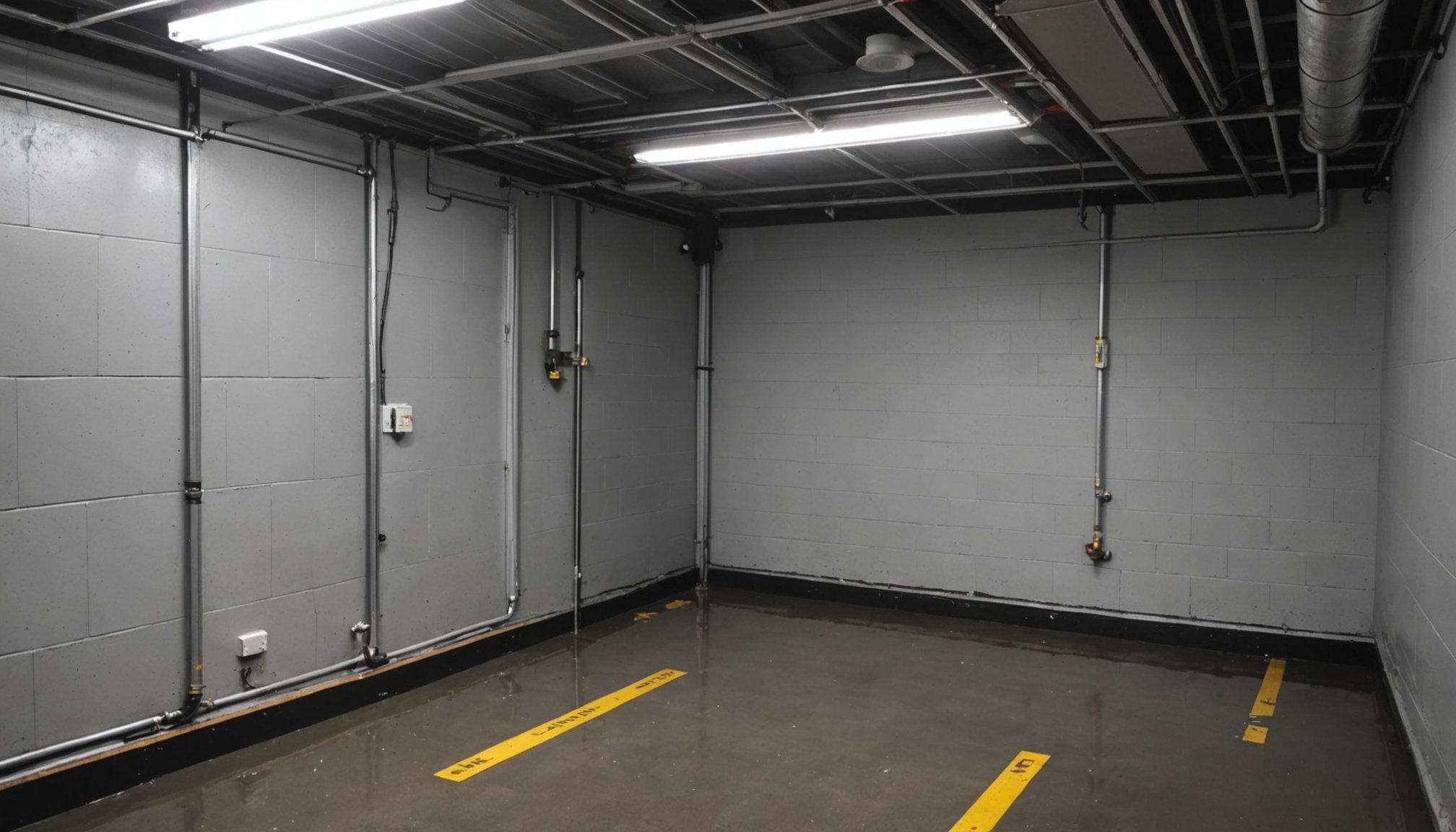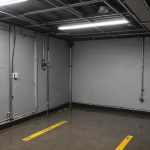Understanding the Importance of Waterproofing Your Basement
In the UK, basement protection is essential due to the region’s frequent rain and high water tables. Neglecting this can lead to significant water damage risks, including structural weakening, mould growth, and ruined belongings. Waterproofing significance lies in its ability to shield your home from these threats.
Focusing on water damage prevention is crucial. Unaddressed, moisture seeping through basement walls and floors can compromise the foundation, leading to costly repairs. Additionally, damp conditions foster mould, which can affect indoor air quality, posing health risks to your family.
Dans le meme genre : Top Toddler-Friendly Stair Gate Solutions for Two-Story Homes in Birmingham: Ensuring Safety and Peace of Mind
With a variety of waterproofing solutions available, homeowners can strategically enhance their home’s resilience. Solutions like exterior waterproofing, interior sealants, and drainage systems ensure that water is effectively channelled away, minimising infiltration. Investing in these tactics fosters long-term safety and peace of mind.
By investing in proper basement protection, you effectively enhance your property’s value and reduce the risk of unforeseen expenses related to water damage. In summary, understanding and implementing effective waterproofing is a proactive measure that prolongs your home’s integrity and ensures a safe, healthy living environment.
A découvrir également : Top Drought-Resilient Plants Perfect for Your UK Garden
Evaluating Common Basement Waterproofing Methods
When it comes to basement waterproofing techniques, understanding the variety of options available can be key to effective home improvement.
Internal Waterproofing Solutions
Internal waterproofing often involves simple methods such as seals, paints, and liners designed to create a moisture barrier on the inside of your basement. These waterproofing techniques include applying special coatings to walls and floors to prevent seepage. While relatively easy to implement, it’s crucial to consider integrating internal drainage systems. These systems can effectively divert water away from potential problem areas. However, relying solely on internal solutions may have drawbacks. They are often best suited for minor or moderate water issues and may not address external root causes.
External Waterproofing Approaches
External waterproofing methods usually involve more extensive work, such as excavation to address water infiltration at its source. This might include foundation waterproofing techniques and installing drainage systems or adjusting landscaping to direct water away from the home. These approaches offer comprehensive solutions by tackling water issues before they penetrate the basement structure. However, they may involve higher costs and require more time and effort due to the need for excavation and professional expertise.
Materials Used in Basement Waterproofing
Basement waterproofing relies on a variety of waterproofing materials and construction supplies to effectively prevent moisture invasion. Barrier solutions are fundamental in ensuring a dry, safe environment.
Membranes and Coatings
Membranes are favoured for their flexibility and efficiency. They form a physical barrier against water, securely protecting basements. Popular types include sheet membranes and liquid-applied membranes. Sheets are easy to apply over large areas, while liquids fit irregular surfaces perfectly. The choice between them often depends on the basement’s unique structure.
Conversely, coatings like cementitious and bituminous offer a more economical solution. Applying coatings is straightforward but might require reapplication over time due to wear or environmental impact.
Selecting the Right Materials
When choosing waterproofing materials, consider basement conditions such as moisture levels, temperature fluctuations, and the structure’s design. Criteria like durability, cost, and ease of application should guide your decision.
- Coarse conditions: Opt for robust membranes.
- Economical choice: Coatings are budget-friendly, though maintenance is necessary.
Using appropriate construction supplies with these barrier solutions enhances longevity. Waterproofing is not one-size-fits-all; an accurate assessment enables optimal material selection, ensuring your basement remains resilient and dry.
Cost Estimates and Budgeting for Waterproofing
Understanding the finances involved in waterproofing can help you make informed decisions. Here’s a breakdown of essential considerations when approaching this task.
Different waterproofing methods come with varying costs. For basic sealant applications, expect to pay between £3 to £5 per square foot. More comprehensive solutions like exterior excavation may range from £80 to £100 per linear foot. Be aware of the specific needs of your space to choose the appropriate method.
When creating a budget, consider hidden costs—these can include initial inspections, maintenance expenses, and even potential repairs for pre-existing damages. Tackling these elements early can prevent financial surprises down the line.
Securing quotes from contractors is crucial for financial planning. To do this efficiently, request detailed estimates that clearly outline the services provided. This not only ensures transparency but also helps manage financial expectations. Typically, contractors provide free quotes; however, it’s wise to confirm this before scheduling consultations.
To manage costs effectively, always compare quotes and, where possible, negotiate discounts for larger projects. Taking these steps ensures that your waterproofing endeavour remains within budget and aligns with your financial strategy.
Understanding Local Regulations and Compliance
Navigating the landscape of UK building regulations is crucial when embarking on any construction project, particularly involving waterproofing. These regulations are stringent, emphasising safety and structural integrity to ensure all building work complies with legal requirements. Before any work commences, obtaining necessary permits is vital. This step confirms adherence to the guidelines and safeguards the project’s legitimacy.
Engaging with local authorities is another essential aspect of the process. These authorities offer guidance and necessary inspections to uphold compliance standards. Regular inspections ensure the project aligns with compliance standards, minimising risks of potential setbacks.
Understanding the relevant UK building codes concerning waterproofing is imperative. These codes detail the specific standards for various materials and techniques used, ensuring durability and effectiveness in construction. Compliance with these codes not only guarantees safety but also enhances the longevity of the building.
Successful navigation of these requirements helps avoid legal complications. It also ensures that the building meets the necessary qualifications for safety and sustainability. Staying informed and involved with local authorities is key to achieving a smooth and compliant building process, paving the way for successful project completion.
Practical Tips for Homeowners
Embarking on a DIY waterproofing project can be both rewarding and cost-effective for any homeowner. To ensure success, a structured approach is crucial. Start with a thorough inspection of your home, identifying areas prone to water exposure. Crucial zones often include basements and external walls. Once identified, clean these surfaces thoroughly and apply a waterproofing membrane or sealant, following the manufacturer’s instructions.
When it comes to maintenance, regularity is key. Check your home’s gutters and downspouts to ensure they are directing water away from your property. Regularly clean them to prevent blockages, which can lead to water pooling and eventually seepage.
For proactive homeowner advice, be vigilant about monitoring for signs of water damage. Look out for discoloured walls, warped flooring, and a persistent musty smell, as these are often indicators of moisture problems. By addressing these signs early, you can mitigate more severe damage and save on costly repairs.
Finally, by integrating these maintenance tips into your routine, you enhance your property’s resilience against water damage, safeguarding your investment. Consistency in application and monitoring ensures the longevity and durability of your home.
Case Studies and Real-Life Examples
Real-life success stories of waterproofing in UK homes offer valuable insights. One noteworthy example is the transformation of a century-old stone cottage plagued by dampness. Using innovative techniques such as cavity drain membranes and specialized sealants, homeowners achieved a completely dry environment. This case illustrates how understanding the unique challenges of a structure is crucial for effective waterproofing.
On the flip side, some homeowner experiences highlight what can go wrong. A London-based flat owner faced recurring issues because of heavy reliance on paint-on sealants without addressing underlying drainage problems. This example emphasizes the importance of comprehensive solutions rather than quick fixes.
Expert insights reveal several best practices derived from real-life examples. Essential strategies include assessing external factors like regional weather patterns, and integrating multi-layered barriers. Experts advocate for a personalised approach, as homes vary widely in construction and the protection they require. For instance, properties near water bodies may need additional sump pumps and drainage solutions to handle potential flooding.
Learning from both successful projects and lessons learned from failures ensures homeowners make informed decisions, safeguarding their property against moisture-related issues.
Additional Resources and Expert Recommendations
Understanding waterproofing involves tapping into valuable resources and heeding expert advice. A proper blend of recommended products, services, and insightful guides can significantly enhance your efforts. Products like waterproof membranes and sealants are popular choices, with many experts advocating for their effectiveness in safeguarding your basement from moisture ingress.
Recommended Products and Services
Consider using sump pumps, dehumidifiers, and waterproofing paint. These items collectively help in mitigating water damage and maintaining a dry environment.
Further Reading Materials
There are several comprehensive guides available online and in literature that offer granulated insights into waterproofing strategies. These resources delve deep into a variety of subjects, from identifying potential water entry points to implementing preventive measures effectively.
FAQs on Basement Waterproofing
-
How can I prevent basement flooding during heavy rain?
Install a robust drainage system and use high-quality waterproof coatings on walls. -
Is professional waterproofing necessary?
Expert evaluations ensure tailored measures suited to your specific basement conditions.
Leveraging these resources and following expert recommendations can make basement waterproofing more manageable and efficient.











